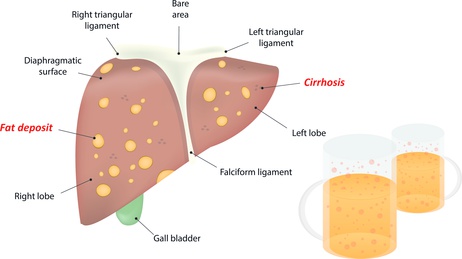The liver is one of the most important in the human body and plays essential roles in numerous functions that the body cannot function without. The liver consists of different parts, including the right lobe and the left lobe, the coronary ligament, the falciform ligament and the ligamentum teres. At the bottom of the liver lies the gallbladder as well. The left and right lobes are the largest parts of the liver. WebMD reports that the liver weighs approximately 1.5 kilograms.
The liver is responsible for numerous functions. Stanford Children’s Health explains that the liver is responsible for bile production, as well as for producing certain proteins that are important for blood plasma. The liver also produces proteins that assist with the transportation of fats, as well as cholesterol production. Glucose is stored in the liver and then released when the body needs it, and stores iron as well. Furthermore, ammonia is converted into urea in the liver, and the liver helps to clear the blood of certain substances that may be harmful to the body, including drugs.
Types Of Liver Diseases
Simply stating that a patient has been diagnosed with liver disease can be confusing as there are many different types of liver diseases, and knowing about each of them is important as this would help a patient determine what exactly is wrong with their liver, how their disease would affect their life and how they can treat the disease they have been diagnosed with. Let’s look at some of the most common types of liver diseases diagnosed amongst the general population:
- Non-Alcoholic Fatty Liver Disease – This type of liver disease causes fat to accumulate within the liver, which impairs the liver’s ability to function properly. It is most common amongst people who are obese.
- Alcoholic Liver Disease – When a person drinks too much alcohol, it causes damage to the liver. This usually occurs over a few years. Continuous misuse of alcohol eventually causes cirrhosis, which can affect the liver’s ability to function and may lead to fatal symptoms when not treated.
- Hepatitis – Hepatitis is an inflammatory condition that causes the liver to swell up. It is most often caused by viral infections in the body, but people who are abusing certain substances, like alcohol, are also more likely to develop hepatitis.
- Primary Biliary Cirrhosis – This is a rare type of liver disease that causes long-term damage to the liver. More specifically, this particular type of liver disease causes damage to bile ducts found in the liver.
Causes Of Liver Diseases
It is well known that excessive alcohol use over an extended period of time causes severe damage to the liver, leading to the developing of alcoholic liver disease. In turn, this can then cause cirrhosis. Eventually, the liver’s function may be severely impaired and this can cause a host of deadly symptoms. Different types of liver diseases are caused by different factors, as listed below:
- Hepatitis A, B, and C is usually caused by a virus or parasites that cause an infection in the liver.
- Genetics are involved with certain types of liver diseases, such as oxalosis, hyperoxaluria, hemochromatosis and Wilson’s disease.
- Abnormalities of the immune system may cause autoimmune hepatitis, primary sclerosing cholangitis, and primary biliary cirrhosis.
- The fat that accumulates in the liver can cause non-alcoholic fatty liver disease.
Conventional Treatment Options For Liver Diseases
There are quite a lot of different treatment options available for liver diseases. Each type of liver disease affects the liver in a different way; thus treatment also defers from one disease to another. In most cases, liver diseases can be treated with medication and, in some cases, with some lifestyle changes, such as giving up alcohol. In severe cases, however, a liver transplant might be needed to save the patient’s life.
Bioresonance Therapy For Liver Diseases
Bioresonance therapy can be used alongside other treatments, or, in some cases, as a standalone treatment option, to assist with the treatment of liver diseases. The appropriate measure will depend on the particular type of liver disease and the severity of the condition. The first step to utilizing bioresonance therapy is to utilize a bicom device to perform several tests, including an energetic test. Thereafter, the particular causes of the patient’s liver problems can be diagnosed with the use of the bicom device.
Once the particular causes have been determined, an appropriate treatment program can be configured on the bicom device to target these causes and reduce the damage that is being dealt to the liver, as well as help to reduce the severity of the symptoms a particular patient is experiencing.
Conclusion
Liver disease can be problematic and lead to symptoms that can be fatal to the patient. Diagnosing and treating potential liver diseases is important, as this can lead to the effective management of the particular disease a patient has been diagnosed with. Bioresonance offers an effective way to treat certain types of liver diseases and disorders by target the aspects that are causing the particular diseases to develop.



